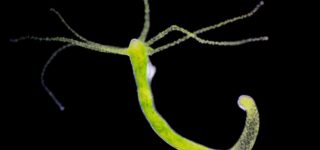
How These 3 Incredible Animals Take ‘Slow Living’ To Another Level
With lifespans stretching far beyond human comprehension, creatures like the hydra, Greenland shark … [+]
There are some species that have persevered through mass extinctions, climate shifts and the relentless pressures of evolution. Others, with their centuries-long lifespans, have outlasted predators, endured environmental shifts and witnessed more of Earth’s history than humans could ever experience.
Such species’ amazingly long lifespans could, interestingly, mean one thing—they probably don’t see time as limited, like we do. Their undemanding metabolisms and extended lifespans suggest that their timeframe is more fluid and drawn out, contrasting sharply with animals that live fast and die young.
They give us a rare glimpse into life’s resilience, standing as living records of the planet’s ever-changing past. Here are three such animals.
1. Hydra, A Tiny Creature That Is Theoretically ‘Immortal’
Beneath the surface of ponds, pools, lakes, streams and similar freshwaters in temperate and tropical parts of the planet, the hydra quietly defies the laws of aging. While most living creatures eventually wear down and die, this small, tentacled organism seems to have found a loophole.
The hydra doesn’t age in the way we understand—it regenerates, constantly renewing its cells, avoiding the typical signs of aging.
Hydra vulgaris under a light microscope. This is a freshwater organism known for its regenerative … [+]
Unlike most animals, which inevitably age and decline, the hydra’s high levels of cell proliferation and its almost-unbelievable regenerative capacity allow it to seemingly escape aging altogether, according to a July 9 paper published in Gerontology.
This ability is due in part to its robust stem cell maintenance, including telomere dynamics that prevent cellular damage, keeping the hydra’s body resilient against diseases and the wear and tear of time.
Under stable conditions with a steady supply of food and through asexual reproduction, many hydra species manage to live indefinitely. In practice, determining exactly how long hydra can live is challenging as they don’t exhibit traditional signs of aging, such as cell deterioration or a fixed lifespan.
Hydra vulgaris, under optimal lab conditions, can live for years—potentially even centuries—without showing signs of senescence (aging). There is no definitive record of their maximum lifespan because they don’t appear to age or die from natural causes related to aging. However, not all hydra species share this biological advantage.
Certain species, like Hydra oligactis, exhibit signs of aging under specific conditions, such as exposure to cold. This provides a valuable contrast for researchers studying what triggers the aging process—and how it might be slowed or even reversed in other organisms.
2. Greenland Shark, The Slowest-Moving Giant With A Centuries-Long Lifespan
Deep beneath the icy waters of the Arctic and North Atlantic Oceans, the Greenland shark moves slowly and silently through its frigid habitat. This mysterious creature holds the title of the longest-living vertebrate, with some individuals estimated to be over 400 years old.
A Greenland shark swims slowly beneath the icy waters of Admiralty Inlet, Nunavut, with an … [+]
In fact, scientists believe one Greenland shark was born around the time Galileo was making his astronomical discoveries, according to an August 2016 paper published in Science. For context, Galileo died in 1642.
The key to the Greenland shark’s incredible longevity lies in its slow metabolism and low body temperature, which allow it to age at an extremely slow rate. It grows only about a centimeter per year and reaches sexual maturity after roughly 150 years—making slow living an entirely different concept for this ancient survivor.
While we are only beginning to understand the full range of factors that contribute to the Greenland shark’s extraordinary lifespan, studying this cold-water predator offers unique insights into how environmental conditions and unhurried metabolic processes can extend life far beyond the norm.
3. Aldabra Giant Tortoise, A Centuries-Old Wanderer of the Indian Ocean
On the remote atolls of the Indian Ocean, the Aldabra giant tortoise moves with slow, deliberate steps, seemingly unfazed by the passage of time. With lifespans often exceeding 150 years, these tortoises are among the longest-living land animals on Earth.
An Aldabra giant tortoise walking slowly on a grassy path, known for its massive size and long … [+]
One individual, named Adwaita, was believed to have lived over 250 years, making it a living relic from centuries past.
Like the Greenland shark, the Aldabra tortoise has a slow metabolism, lives a simple lifestyle and experiences relatively low stress in its natural habitat. Protected by its immense shell, this ancient species has survived on Earth through changing climates, sea levels and human presence, outlasting many other creatures that once lived in this island region, like the dodo.
These ancient species do more than simply survive—they serve as living models of evolutionary adaptation, each having mastered unique strategies to endure through the millennia.
Their longevity is a window into the evolutionary mechanisms that govern aging, regeneration and survival. By studying the hydra’s cellular immortality, the Greenland shark’s leisurely metabolic pace and the Aldabra tortoise’s stress-resistant lifestyle, we are able to take a glimpse into the interplay between genetics and environment.
To fully appreciate their significance, we must reconnect with nature—recognizing that our own survival and longevity are intertwined with the ecosystems that have sustained life for millions of years. To find out where you fit into the natural world, explore this link: Connectedness To Nature Scale



